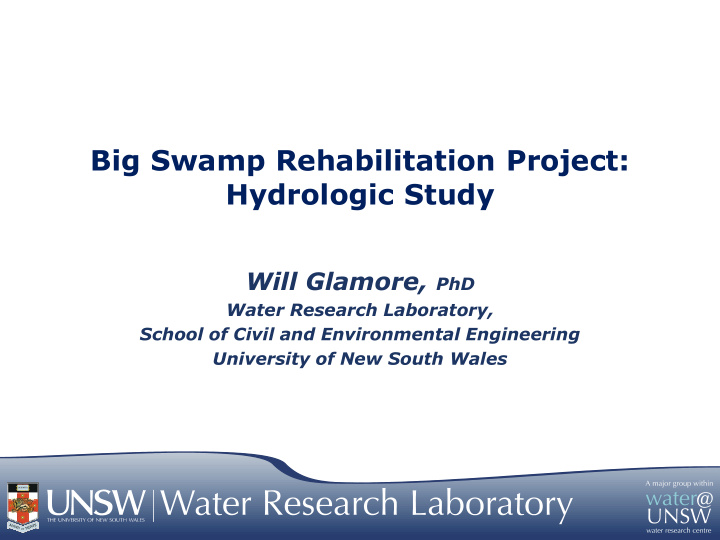



Big Swamp Rehabilitation Project: Hydrologic Study Will Glamore, PhD Water Research Laboratory, School of Civil and Environmental Engineering University of New South Wales
Introduction Definitions: • Big Swamp • Pipeclay Canal • Cattai Creek Technical Terms: • Hydrology • Hydrodynamics • Groundwater • Hydraulic Head • Acidity (pH) • Modelling
Introduction
Logic of Study and Report 1. How did we get here?
Conceptual Understanding • Manning River catchment • Average annual rainfall at is 8,420 km 2 Moorland gauge is 1,436 mm but seasonal. • Big Swamp-Pipeclay catchment is 113 km 2 or • ~2000 hectares below 0 m ~1% of total. AHD (mean sea tide)
Conceptual Understanding
Conceptual Understanding
Conceptual Understanding Drainage History • 1899 Big Swamp Drainage Scheme Approved • 1905 completed • Designed to pass upland catchment directly to Cattai Creek • Big Swamp drainage was secondary issue • Expanded in 1960s and 90s.
Conceptual Understanding
Tide, Drains and Acid Sulfate Soils
DRY Conditions
Flood Conditions
Draining Conditions
Conceptual into Actual What happens at Big Swamp?
Field Data Collection Feb June Sept
Field Data Collection Program
Field Data Collection Program
Elevation Data Check
Cross-Sections and Culverts • 33 Cross-sections taken from upstream of Pipeclay canal to bridge near Harrington. • Plus every known culvert/structure • All based on high precision RTK-GPS positioning.
Field Data Collection Program
New Instruments Installed
Cattai Creek Logger
Upper Pipeclay Canal Logger
RESULTS: Dry Conditions
Wet Conditions- Flooding on Big Swamp • Levee Bank at 1.8m AHD • 1% ARI = 3.1 m AHD • A 100 year event is required to flood Big Swamp over the levee banks from local catchment runoff • Levee banks overtop from back-flooding of Manning River at ~10 yr event.
Flooding
Flood Event: March 1978 (1.3% AEP) 12000 Killawarra Hydrograph: March 1978 Flood Pipeclay Creek Hydrograph: March 1978 Flood 10000 8000 Flow (m3/s) 6000 4000 2000 0 0 10 20 30 40 50 60 70 80 Time (hrs)
Flood Event: May 1977 (15% AEP) 6000 Killawarra Hydrograph: May 1977 Flood Pipeclay Creek Hydrograph: May 1977 Flood 5000 4000 Flow (m3/s) 3000 2000 1000 0 0 20 40 60 80 100 120 Time (hrs)
>200 mm of rainfall was recorded at the site in 3 days in late Jan 2013
Wet Conditions: Jan-Feb 2013
On-ground Impacts
Remediation Options What can we do?
Priority Assessment • Developed Method to determine which areas are highest priority and should be remediated. • Based on: Groundwater/Soil • Acidity • Surface water • Total discharge • • Areas 1/7 and 0/6 were highest priority
Restoration Options • Objective is to remediate • On-ground works: acid problem by: Encourage neutralisation at • source by removing Dilution • floodgates and levee sections Neutralisation • Prevent further acid creation • Reduction • by infilling drains and keeping wet • Aim is to: Reduce acid transport by • Improve water quality • removing floodgates and filling drains Reduce acid ponding • Encourage reduction of Improve ecology • • existing acid Decrease acid discharges • Ensure no impact to flooding from soil • and limit stagnant water.
Computer Model • Computer model developed using the field data to: Assess conceptual model • Simulate existing scenaro • Modify model to test: • • No floodgates anywhere • Selected restoration options • Dry versus wet scenarios • Plan for on-ground works
Computer Model
Model Results
Existing Site Drainage
Scenario: No Floodgates
S-W Remediation Options
S-E Remediation Option
Restoration Options
Summary • Restoring S-W and S-E areas will remove large high priority acid zones. • The S-E zone will not be fully restored as it still requires drainage. • The remediation works will not impact flooding elsewhere. • Any overland inundation will be shallow and intermittent.
Recommendations • On-ground works Floodgates • Levees • Drain modification and • construction Land grading • • Future Monitoring Continuous sampling • Before-After sampling • Photo points • • Proceed with Additional Restoration Sites • Proceed with Plan of Management
Acknowledgments • Greater Taree City Council Mr Dave Hopper • Various field support staff • • Wetland Care Australia • Various stakeholders and volunteers • Landholders for Access to Monitoring Stations
Recommend
More recommend